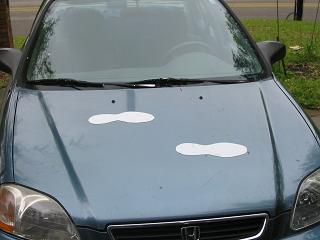I have upgraded the worm bin to worm bin 2.0. It was previously a toybox but it has been storing blankets and discards for a year or more. My wife wanted it out of the office so she could move the futon there.
This is a huge upgrade. The old plastic worm bin had poor ventilation and a lot of moisture problems. I had placed a new sponge and a dessicant pack from some recent electronics purchase (not the tiny sugar packet size, the resin bag size) inside the bin and it still glistened from moisture.
The new bin has no such problems. I used the doorknob hole bit on the drill to put ventilation holes along the bottom of one end and and along the top of the other end. I duct-taped screen in place across all holes and made a rather tidy job of it. The bin has no moisture problem. In fact, I fear I might need to add water. It sits up off the ground about two inches. I drilled a few quarter inch drain holes in the bottom so it could drain water if needed. It is a wooden bin, or as close to wood as anything is anymore: some kind of laminate. The hinge on the top is designed to not open more than about a 60 degree angle, which is the only annoying thing about the box.
The worms are thriving, even though the heat is already into the 90s. The bin is in the garage and I have stopped worrying about the worms overheating.
Here is the best new thing about the worm bin, though: black soldier fly larvae. Yeah. I opened up the bin last week and had that Indiana Jones moment. "Why does the floor move?" The bin was crawling with these black-and-white maggots. Big ones. Not housefly maggots. Not "That's not rice. Michael, you're eating maggots." Not those kind. These look almost like mealworms.
A first I was worried and then I read up on the BSFL as they are called. They're cool. They're buds with the wigglers. They help with the composting. And that's the goal. I mean, I'm not a worm farmer. The goal isn't to have lots of healthy worms. The goal is to compost the kitchen waste and have awesome castings for my plants. So let the BSFL help.
Here is my only worry. Larva are just kids. Someday they grow up. When that happens, I will have black soldier flies. I don't want a lot of them in the garage. I guess the larva I have had to come from somewhere. That implies I already have black soldier flies in the garage in some quantity. I just don't want these cute little fellas to grow up and fly away. I want them to keep working for me.
One final note which will seem obvious once I point it out. Black soldier flies are insects. Their larva are immature insects. Not worms. Eisenia fetida are roundworms, not insects. These are completely different phyla from the animal kingdom. They are all small critters, so it is easy to lump them together but they are fundamentally different. This is a good lesson for the kids.
1930s Braised Cube Steak Dinner
1 week ago




